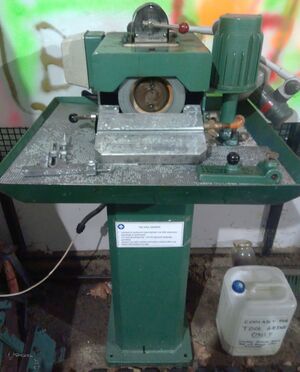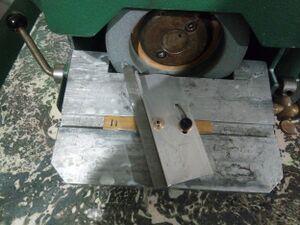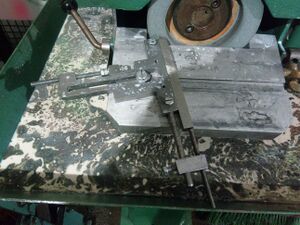Equipment/RJH Tool Grinder
This is a dedicated tool grinder intended for removing small amounts of material to shape heat-sensitive steel cutting tools to specific geometry. It is not a general-purpose metal shaping and grinding tool - the regular bench grinder (on the opposite side of the cage) is a much better tool for this purpose.
Training is required for this tool it will be included in lathe training. It is powered via a 16A plug, the extension lead for which is kept in the metal shop toolroom (which is ACNoded) - please do not attempt to use this grinder if you do not have access to the toolroom
Note that this grinder must be used with a coolant - a separate bottle is located next to the machine which must be tipped into the sump of the grinder before operating. The coolant must be drained out between uses - there is a hose with an inline tap at the front right corner of the grinder for this purpose. Note that this coolant is topped up from the same bottle of oil used for the mill and lathe but once used on the grinder, this coolant will be contaminated with abrasive sludge that will damage other tools so please keep the used coolant separate. The coolant bottle normally lives next to the grinder although in the winter months please keep it in the toolroom - the constant spray during use will numb your hands very quickly if the liquid is cold
The coolant sump is covered during normal use with a perforated sheetmetal cover, this is useful to stop you dropping tools into the liquid. It does however stop you being able to set the table at the lower end of its range. The cover can easily be removed by lifting the table to its highest position then pulling the cover out, and replaced the same way at the end of a session
Note the original pedestal was scrapped in 2024 to save space
Accessory - Wheel Dressing Tool
There is a wheel dressing tool kept in the metal shop toolroom. This should be used periodically to straighten the face of the wheel and clear out any debris. To use it, extend the dressing tip as little as possible from the jig then run side to side along the tool slot to dress the wheel. Do not remove more wheel than necessary or dress too often as this will reduce the life of the wheel
Accessory - Angle Setting Jigs
We have constructed 2 angle-settings jig which hold tools at a specified angle for grinding (also kept in toolroom). The first jig is much easier to use and can be used to set end-grinding angles, while the second jig can be used for grinding at other angles (e.g. plunge cutting) and also features feed screws which can control the depth of cut.
Risk Assessment - Stationary Grinders
This risk assessment is intended to provide guidance on the risk associated with the above equipment and activities in normal use. Please also check general risk assessments for the space as a whole. Any discrepancies, errors or concerns should be raised with the document maintainers or trustees - do not edit this assessment directly. For responsible persons and last update, see 'version log' of the assessment page.
Activity
Grinding metal with stationary grinders such as bench grinders, belt grinders, linishers, tool & cutter grinders
Signage
Understanding Risk Rating
LOW - Ensure current control measures are in place and continue with activity
MED - Control measures may be adequate, co-supervision is recommended
HIGH - Do not undertake activity without further consultation with area specialists
Risk Assessment
| Identify Hazards | Who May be Harmed and How | Severity | Control Measures | Likelihood | Risk Rating |
|---|---|---|---|---|---|
| General Power Tool Handing | Users, bystanders | High | Members are competent to carry out work. Tools and cables are visually inspected before use. Damaged tools are withdrawn from service for repair or replacement. All members will wear personal protective equipment as specified for the task. Specified Eye protection must be worn at all times when carrying out this activity. | Medium | Medium |
| Hot work | Users, bystanders | High | It should be ensured that there is no combustible material in close proximity to the work. Suitable protection should be provided for any combustible items that cannot be moved and for combustible construction such as wooden worktops. A check should be carried out on all of the surrounding areas to minimise the possibility of ignition by heat transfer. Fire extinguishers are provided at the space. Hot work should be stopped a reasonable time before leaving the space. A thorough inspection of the area should be undertaken once the work is complete after completion. Where necessary, a further check should be carried out before leaving the space. | Medium | Medium |
| Flying debris | Users, bystanders | High | Members are competent to operate the grinder and will wear safety goggles provided when grinding. Where necessary, suitable screens must be positioned to protect others from flying debris. | Medium | Medium |
| Waste management | Users, bystanders | Medium | Grinding debris will be segregated, where possible, by starting with a clear collection area and clearing on completion. Metal debris will be hot and should be directed into a suitable bin. | Medium | Low |
| Workpiece movement | Users, bystanders | Medium | The grinder must be suitably positioned at a comfortable working height. It must be secured in place to prevent movement by grinding pressure or vibration | Medium | Low |
| Noise / Vibration | Users, bystanders | Medium | Members are provided with and wear suitable hearing protection when using the grinder. They will also comply when working in designated hearing protection zones. Minimise the time members are exposed to vibration i.e. members should take breaks during long jobs. | Medium | Low |


